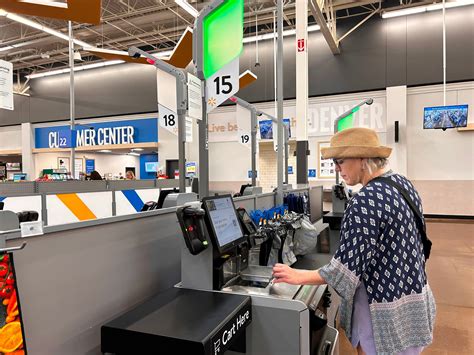
Walmart is scaling back self-checkout lanes at some stores, driven by data indicating increased theft and losses, with police data playing a significant role in the decision-making process. The retail giant is reevaluating its self-checkout strategy across select locations to combat rising shrink and improve the overall customer experience.
Walmart is making strategic adjustments to its self-checkout lanes in certain stores following internal data analysis and collaboration with local law enforcement, which revealed a correlation between self-checkout availability and increased shoplifting and inventory shrinkage. The company is implementing changes that range from completely removing self-checkout options to limiting their availability during specific hours or restricting their use to Walmart+ subscribers and customers purchasing a limited number of items. These changes aim to mitigate losses and enhance customer service by shifting resources to staffed checkout lanes.
The move comes as retailers nationwide grapple with escalating rates of retail theft, often referred to as “shrink,” which encompasses losses due to shoplifting, employee theft, vendor fraud, and administrative errors. Walmart, as one of the largest retailers in the United States, has been particularly affected by this trend, leading the company to explore various strategies to combat it. “Shrink is an issue for every retailer,” Walmart CEO Doug McMillon stated in December 2022, noting it had increased.
The decision to alter self-checkout availability is multifaceted, combining the need to reduce losses with the goal of providing a better shopping experience for customers. Walmart is carefully monitoring the impact of these changes, using data to determine the most effective strategies for each store location. The company acknowledges that self-checkout, while offering convenience for many shoppers, has also been exploited by some individuals, contributing to higher rates of theft.
Walmart’s approach varies by location, reflecting the diverse needs and challenges faced by individual stores. Some stores are eliminating self-checkout lanes altogether, opting to rely solely on staffed checkout options. Other locations are limiting the hours during which self-checkout is available, typically restricting its use to peak shopping times when more employees are available to monitor the lanes. Additionally, certain stores are reserving self-checkout for Walmart+ members or customers with a small number of items, incentivizing membership while reducing the potential for large-scale theft.
The changes at Walmart mirror similar adjustments being made by other retailers across the country. Target, Kroger, and other major chains have also been experimenting with different self-checkout strategies in response to rising theft rates. These strategies include increasing employee presence in self-checkout areas, implementing advanced surveillance technology, and adjusting store layouts to improve visibility and deter shoplifting.
Walmart’s steps to re-evaluate and modify their self-checkout policies are the result of a detailed assessment of the cost-benefit analysis. The initial investment and continued maintenance of self-checkout lanes were undertaken with the goals of reducing labor costs, speeding up transaction times, and enhancing customer convenience. However, the unexpected rise in theft-related losses has forced the company to reconsider whether these benefits still outweigh the costs.
The decision-making process at Walmart also includes leveraging data analytics to identify stores with the highest rates of self-checkout related theft. By analyzing transaction data, inventory records, and incident reports, Walmart can pinpoint specific stores and even specific times of day when theft is most prevalent. This allows the company to implement targeted interventions, such as increasing staffing during high-risk periods or reconfiguring store layouts to improve visibility and deter theft.
The company’s collaboration with local law enforcement has been critical in understanding the patterns and drivers of retail crime. By sharing data and insights with police departments, Walmart can help law enforcement agencies identify repeat offenders, track stolen merchandise, and develop strategies to prevent future incidents. This collaboration also helps Walmart stay informed about emerging trends in retail crime, such as organized retail theft rings that target high-value items.
The changes to self-checkout lanes are part of a broader effort by Walmart to enhance security measures across its stores. Other initiatives include increasing the use of security cameras, implementing electronic article surveillance (EAS) systems, and training employees to identify and respond to potential theft incidents. Walmart is also investing in technology that can detect fraudulent transactions and prevent theft at the point of sale.
The customer experience is a key consideration in Walmart’s decision to modify self-checkout lanes. While self-checkout can be convenient for some shoppers, it can also be frustrating for others, particularly those who encounter technical difficulties or have questions about the checkout process. By increasing the number of staffed checkout lanes and providing more employee assistance, Walmart aims to improve the overall shopping experience for all customers.
Walmart’s efforts to address retail theft are not limited to its physical stores. The company is also taking steps to combat online fraud and theft, which has become an increasing concern for retailers in recent years. Walmart is using advanced data analytics and machine learning algorithms to detect and prevent fraudulent transactions on its website and mobile app. The company is also working with law enforcement agencies to investigate and prosecute online fraudsters.
The impact of Walmart’s changes to self-checkout lanes extends beyond the company itself. As one of the largest employers in the United States, Walmart’s decisions can have a significant impact on the retail industry as a whole. Other retailers are closely watching Walmart’s experiment with self-checkout strategies, and many are likely to adopt similar measures if they prove to be effective.
Walmart’s actions also have implications for consumers. While some shoppers may be inconvenienced by the reduction in self-checkout lanes, others may appreciate the increased availability of staffed checkout options and the improved customer service. The changes may also lead to higher prices for consumers if retailers are forced to pass on the costs of increased security measures.
Walmart’s strategic shift regarding self-checkout lanes highlights the ongoing challenges faced by retailers in balancing convenience, security, and profitability. The company’s data-driven approach and collaboration with law enforcement demonstrate a commitment to addressing retail theft in a comprehensive and effective manner. The ultimate success of these changes will depend on Walmart’s ability to adapt to evolving trends in retail crime and to provide a positive shopping experience for its customers.
In response to the rising concerns surrounding retail theft, Walmart has implemented several key strategies aimed at mitigating losses and enhancing the overall shopping environment. These strategies include:
-
Enhanced Security Measures: Walmart has increased its investment in security technology, including advanced surveillance systems, anti-theft devices, and real-time monitoring capabilities. These measures are designed to deter potential shoplifters and provide valuable evidence in the event of a theft incident.
-
Employee Training and Awareness: Walmart is providing its employees with comprehensive training on how to identify and respond to suspicious behavior, prevent theft, and provide assistance to customers. By empowering employees to be vigilant and proactive, Walmart aims to create a safer and more secure shopping environment.
-
Collaboration with Law Enforcement: Walmart is actively collaborating with local law enforcement agencies to share information, track crime trends, and coordinate efforts to prevent and prosecute retail theft. This partnership helps Walmart stay informed about emerging threats and develop effective strategies to combat them.
-
Data Analytics and Predictive Modeling: Walmart is leveraging data analytics and predictive modeling techniques to identify high-risk areas and patterns of theft. By analyzing transaction data, inventory records, and incident reports, Walmart can pinpoint specific stores and times of day when theft is most likely to occur, allowing the company to deploy resources strategically and prevent future incidents.
-
Store Layout and Design Modifications: Walmart is making changes to its store layouts and designs to improve visibility, reduce blind spots, and deter shoplifting. These modifications include moving high-value items to more secure locations, installing mirrors to increase visibility, and optimizing the placement of security cameras.
By implementing these comprehensive strategies, Walmart aims to create a safer and more secure shopping environment for its customers and employees, while also reducing losses due to retail theft. The company’s commitment to addressing this issue demonstrates its dedication to protecting its assets and providing a positive shopping experience for all.
The impact of retail theft extends beyond financial losses for retailers. It also affects consumers, employees, and communities in various ways. Some of the key consequences of retail theft include:
-
Higher Prices for Consumers: Retailers often pass on the costs of retail theft to consumers in the form of higher prices. As retailers lose money due to theft, they may increase prices on goods and services to offset those losses, effectively making consumers pay for the crimes committed by shoplifters.
-
Reduced Product Availability: In some cases, retail theft can lead to reduced product availability, particularly for high-value or frequently stolen items. Retailers may choose to limit the quantity of certain products on shelves or even discontinue selling them altogether if they are repeatedly targeted by shoplifters.
-
Increased Security Measures: Retail theft can also lead to increased security measures in stores, such as more security cameras, anti-theft devices, and security personnel. While these measures may help deter theft, they can also create a less welcoming and more intrusive shopping environment for customers.
-
Job Losses: In extreme cases, retail theft can lead to job losses for retail employees. If a store experiences significant losses due to theft, it may be forced to reduce staff or even close down altogether, resulting in job losses for employees.
-
Negative Impact on Communities: Retail theft can also have a negative impact on communities by creating a sense of insecurity and eroding the quality of life. Stores that are frequently targeted by shoplifters may become less attractive to customers and may even close down, leaving communities without access to essential goods and services.
By understanding the far-reaching consequences of retail theft, it becomes clear that addressing this issue is crucial for protecting retailers, consumers, employees, and communities.
Walmart’s adjustments to its self-checkout lanes are not occurring in a vacuum. The retail industry is facing a confluence of factors that are contributing to the rise in retail theft and prompting retailers to rethink their strategies. These factors include:
-
Economic Conditions: Economic downturns and periods of high unemployment can lead to an increase in retail theft as people struggle to make ends meet. When individuals are facing financial hardship, they may be more likely to resort to shoplifting to obtain essential goods.
-
Social and Cultural Factors: Social and cultural factors can also play a role in retail theft. For example, some studies have shown that certain social groups may be more likely to engage in shoplifting due to factors such as poverty, lack of opportunity, or a sense of entitlement.
-
Changes in Retail Technology: The rise of self-checkout lanes and other retail technologies has inadvertently created new opportunities for theft. Self-checkout lanes, while convenient for customers, can be easier to exploit by shoplifters who are able to bypass security measures or scan items incorrectly.
-
Organized Retail Crime: Organized retail crime, which involves professional shoplifters who steal merchandise for resale, is a growing problem for retailers. These organized crime rings often target high-value items and can cause significant financial losses for retailers.
-
Changes in Law Enforcement Priorities: In some areas, law enforcement agencies may be facing budget cuts or shifting priorities that make it more difficult to investigate and prosecute retail theft cases. This can embolden shoplifters and lead to an increase in retail theft.
By understanding these underlying factors, retailers can develop more effective strategies to address retail theft and create a safer and more secure shopping environment for their customers and employees.
Frequently Asked Questions (FAQ)
1. Why is Walmart reducing or eliminating self-checkout lanes?
Walmart is making these changes due to data indicating increased theft and losses associated with self-checkout lanes. Collaboration with law enforcement also revealed a correlation between self-checkout availability and increased shoplifting. The goal is to mitigate losses and improve the customer experience. As stated by CEO Doug McMillon in December 2022, “Shrink is an issue for every retailer,” and it had been increasing.
2. How is Walmart deciding which stores will have changes to their self-checkout options?
Walmart uses a data-driven approach, analyzing transaction data, inventory records, and incident reports to identify stores with the highest rates of self-checkout related theft. This allows them to implement targeted interventions based on specific needs and challenges at each location.
3. What are the different types of changes Walmart is making to self-checkout lanes?
The changes vary by location and include:
- Eliminating self-checkout lanes entirely.
- Limiting the hours during which self-checkout is available.
- Reserving self-checkout for Walmart+ members.
- Restricting self-checkout to customers with a small number of items.
4. Are other retailers also making changes to their self-checkout options?
Yes, other major retailers like Target and Kroger are also experimenting with different self-checkout strategies in response to rising theft rates. These strategies include increasing employee presence, implementing advanced surveillance technology, and adjusting store layouts.
5. How will these changes affect Walmart customers?
The impact on customers may vary. Some may experience inconvenience due to reduced self-checkout options, while others may benefit from increased availability of staffed checkout lanes and improved customer service. Prices could potentially increase if Walmart needs to pass on the costs of increased security measures.
Walmart’s decision to adjust its self-checkout strategy reflects a broader trend in the retail industry as companies grapple with rising rates of theft and evolving consumer expectations. The company’s data-driven approach, coupled with its collaboration with law enforcement, highlights the complex challenges faced by retailers in balancing convenience, security, and profitability. As Walmart continues to refine its strategies, it will be important to monitor the impact of these changes on both its bottom line and the overall shopping experience for its customers. The long-term success of Walmart’s efforts will depend on its ability to adapt to evolving trends in retail crime and to create a shopping environment that is both secure and customer-friendly.









